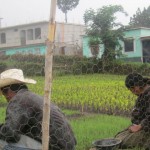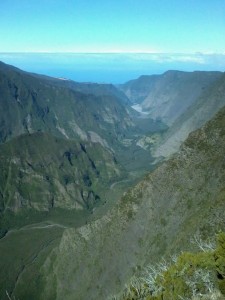Scientist vs. Local
The scientist and local represent two identities which may be formed against one another in the institution of protected areas. They often use different frameworks. As an accredited researcher, scientists will have methods possibly focussed on global models, and physical sciences. Locals on the other hand, often have histories of their environment and communication with neighbors that call attention to problems. Local observations and the knowledge of scientists can be used to work towards a common goal.

The identities can result in different discourses. Environmental discourse affects how people both investors, supporters to a cause, or to differing levels of human settlements respond . “Protected” can have different connotations for people. The relationship between scientist and local play a role in the acceptance of narratives, constructed images, solutions, and a environmental problems as problems.
“Forest Developers, Forest Protectors: Commercial Agroforestry by the Chiripá of Paraguay”
Use of natural resources by local populations is often presented as degrading to biodiversity in tropical ecosystems. However, the environment perceived as “natural” and separate from humans has had human intervention for generations. Richard Reed discusses the effectiveness and sustainability of agroforestry. Agroforestry is an economically, environmentally, culturally sustainable and profitable practice. Reed believes more Amazonian populations could benefit through agroforestry, where the use of a culture’s environmental knowledge is applied to land. Reed’s research is based off previous agroforestry studies on the Chiripá of Paraguay. Agroforestry practices replicate tropical forest ecosystems. Chiripá labor is divided between horticulture, hunting, fishing, and commercial extraction such as the marketing of yerba. Subsistence farming provides families with a more reliable source of income. Extraction cycles and divisions of labor prevent the exhaustion of resources.
Reed’s article is important because certain practices, such as agriculture and commercial extraction, are viewed as negating forest management and protection. The use of natural resources however, can be conducive to the management and health of land. This article presents a contrasting viewpoint to Sodikoff’s article, where the relationship between conservation and production are observed as incompatible.
“Land Tenure and REDD+: the Good, the Bad, and the Ugly”
Conflict over land and lost tenure rights are not uncommon issues in the conservation of natural resources. Larson et. al evaluates REDD+, a program that regulates use of forest resources and compensates “developing” countries for the financial opportunity cost of maintaining in carbon sequestration. Information is compiled from interviews from technical staff and villagers on the project sites, research by Center for International Forestry Research (CIFOR) and the GCS-REDD project addressing national stakeholders, policies, and processes, and subnational projects for REDD+. Larson et al focus on Brazil, Indonesia, Tanzania, Vietnam, Cameroon. Land tenure is mainly public and held by the government.

Larson et. al find discussion and problem solving are framed around politics and policy making rather than land tenure; yet, many NGOs and civil groups position themselves around governance and land tenure rights. For some minorities, they don’t take advantage of the opportunities. At a local level, there are opportunities presented but would benefit from a national program. Still, even though REDD provides compensation, awareness of the compensation is not widespread. Problems created in the value making of REDD policies are overlooked. can play a role in tenure reform on behalf of those in tenure conflict.
Land rights may be an ethical sacrifice resulting from conservation efforts. Distinguishing between environmental protection and human rights can result in harm to one or both parties, a dynamic addressed in “Stolen Apes.”
“The Power of Environmental Knowledge: Ethnoecology and Environmental Conflicts in Mexican Conservation”

Conservationists, governments, and locals may have competing interests and perceptions of the environment. These interests can be reflected in constructed anti-identities. Nora Haenn examines the differing approaches to the environment. She collects data from the Calakmul Biosphere Reserve in Mexico. Conflict has occurred over forest resources between campesinos (swidden farmers) and conservationists. Each party has different perceptions of land use – the campesinos feel the forest is a powerful force requiring social control and labor, while conservationists believe the reserve needs a hands off approach.
Haenn explores conflicts in the reserve as the origination of differences in knowledge and identity. Knowledge affects how one party approaches another and their perceptions and beliefs. The campesino class identity is only formed in opposition to the conservationist identity. Despite differences among the campesinos, they have a shared identity because there is an opposing group. When a compromise promising developmental programs was reached, resistance to conservation continued. Campesinos however, have learned how to speak the language of conservation however, in a way that allows easier communication between parties.
As Tsing describes in “Friction” the presence of one identity creates the presence of another. These identities complex such that they are not restricted to a divide between the rich and poor. Assumption that humans will destroy nature. The work draws on Nazarea’s ethnoecologies and Milton’s comparisons of nature and culture.
“But I Know it is True: Environmental Risk Assessment, Justice, Anthropology”
Environmental assessments can be informed by several frameworks such as the physical, life, and social sciences. The knowledge of the scientist however, often reigns over other sources of knowledge. This can have implications to environmental justice. Melissa Checker pushes for these hierarchal barriers to be broken down so that the scientist and the local can work together in environmental risk assessment. Her data is taken the EPA and from Black residents in Augusta, Georgia’s Hyde Park.

Checker analyzes the approach taken by the EPA and scientists in determining environmental risk and relates it to the stories of pollution told by residents. Residents reported harmful contamination, but EPA reports contradicted these complaints. The residents were found to be correct in their fears. Indices and references from other populations cannot always reflect the size, genetics, or geography of a population. Risk assessments can be entangled in cultural stereotypes. Had there been a greater outreach towards residents, the problem could have been remedied sooner. Checker suggests that more collaborations should occur for a. Science does not always identify problems nor does it have the solution. For locals living in an approached environment, they can give a different, but equally informed perspective on the processes around them.
It is important to note that just because a person is of a certain socioeconomic status, education level, or region, does not mean that they cannot understand that a problem is in their midst. On the same note, their lack of seeing a problem does mean that they are ignorant. Authority figures in environmental management and protection should be questioned because there is not one way to approach the environment.This relates to Messerschmidt’s article in the perceived ignorance of the locals in environmental matters.
Entry 18: “How Do We Know We Have Global Environmental Problems?”

Environmental problems are defined as global, a term that can result in predictions that are inconsistent with regional processes. So, Taylor and Buttel, ask that we question this term. They look at data from global models of the past and present, and discourse surrounding the term. They analyze how a global perspective on the environment has played out at a regional and international scale. Designation of environmental processes as a problem is largely political. Certain models and research, often regarding climate, can be supported over others. A moral and technocratic discourse follows the term. Solutions become based in what we should do as global citizens with a shared problem such that international agencies like the United Nations and World Bank are formed. The form of aid given by these agencies however can play a role in increasing environmental degradation.
Their analysis points to a hierarchy of physical sciences over social science that should be erased. Checker relates to the focus on scientific authority figures as policy drivers. This article is important because environmental destruction is widely referred to in global terms. A global problem can expound a presented image of environmental destruction in one part of the world to a seemingly similar part of the world. Responsibility of environmental destruction in placed everyone’s hands no matter the contribution. Protected areas can have an international touch, in that many of them are structured similarly from country to country as a “fortress” or with buffer zones, core areas, multi-use zones, or transition areas. The efficiency of a protected area however, is largely dependent on regions. They would not prove a global solution to a global problem such as deforestation.
“False Forest History “
In the environmental discourse, there is a commonly defended narrative that the world’s resources are finite and are being consumed, destroyed, or degraded at an alarming rate. James Fairhead and Mellisa Leach analyze this narrative through its comparison to a counternarrative.

The loss of forest cover in Kissidougou, Guinea is the focus of the article alongside savanna and farming regions. On one side are narratives of population growth, farming, and modernity as reasons for loss of forest cover. Policy makers and officials use soil science, and geographic studies to support their premises about the role locals play in deforestation. On the other side are aerial photographs and the local knowledge of the past is evidence which implicates there has not been as much forest lost as is implied which do not show a major decrease in forest cover. Through the counternarrative, Fairhead and Leach do not try to say that all scientific research is incorrect. Their goal is instead to illustrate that what is taken to be fact must be questioned.
Social constructs and power have an affect on the narrative that is told. Farming, for example, is often seen as destructive. Contrary to belief, villagers’ practices cam encourage forest growth rather than degrade, it. In the case of Kissidougou, locals were repeating what was said by officials.
Information can be taken for granted as correct regarding environmental management. When information that is taken for granted is used as the basis for studies, actions, and policy, environmental management can end up playing a role in social, political, and environmental degradation.
“Ethics Primer for University Students Intending to Become Natural Resources Managers and Administrators”
Richard J McNeil focuses on differing ethical stances that can be applied to environmental management. The standpoints are presented from different philosophers of the past. Alone, one ethical view creates the possibility of excluding one population that could argumentatively be included by another view. There are views which are more anthropocentric, and others which are more biocentric or ecocentric.
McNeil does not say that one standpoint is better than another. A decision is usually the combination of more than one ethical viewpoint. There is no right or wrong view for ethics. In the same way, there is no one right approach to environmental management. Different groups of people think in different ethical frameworks. On the other hand, values are ascribed to different living beings and the inanimate that can be debated even within a group of people living and interacting with each other in the same environment.

Questioning the source, values, and reasoning behind a theory based in ethics is important. McNeil argues that researchers, policy makers, and constituents often act with ethical intent without fully understanding the ethical consequences of their actions. Similarly, a person’s ethical reasoning behind an action or decision might be considered to withstand scrutiny. Were that reasoning to be analyzed, the ethics of that decision might prove less stable.
In the environmental management of protected areas, sometimes locals who once lived in the area are given less rights than the flora and fauna within the borders. The decision of what is to be protected may fall to the hands of a select few. “The Anti-Politics Machine” exemplifies what can happen with “good” intentions in environmental management and development.